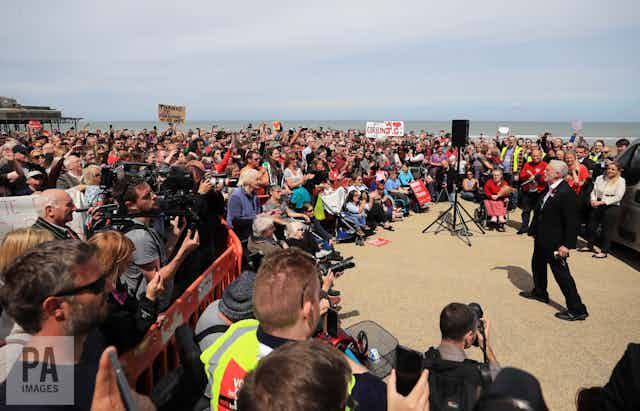For Wales, the short path to this election has been anything but an easy one. After initial polling suggested it was going to be a landslide win for the Welsh Conservatives, many were left wondering just how much of a traditional Labour heartland the nation could truly be.
But as the weeks of campaigning wore on opinions started to change, to the point where it was predicted that Labour would not only hold their 25 seats but take a further two back from the Conservatives.
It’s safe to say that on the night, however, Labour exceeded all expectations in Wales. Ending the night with 28 of the 40 seats and 48.9% of the vote. The party has outperformed every single Wales-only poll over the course of the campaign, as well as the exit poll, where it was forecast that the Conservatives would take five seats from Labour.
Welsh Labour – and it is important to make that distinction, for it led a campaign of “shared ambitions” with the national party and Jeremy Corbyn in the background – has now achieved its highest share of the vote in Wales since 2001.
Though the Conservative Party tried its best to take some of the more marginal seats between it and Labour, such as Bridgend and Newport West, Labour successfully defended all of its 25 seats and took a further three (Gower, Cardiff North, and Vale of Clwyd) from the Conservatives. This is Labour’s best performance in terms of seat share since 2005 and extends their electoral dominance in Wales to 26 general elections in a row.
Welsh Conservatives
Despite shock gains in 2015 – the party picked up the Gower constituency, which had been under Labour control for 100 years, by just 27 votes – the Welsh Conservatives have continued their historical trend of performing considerably worse in Wales than in England. The best they have fared in the past century was to hold 14 of the then 38 seats in 1983. Though this dropped year on year until 1997, when the Welsh Conservatives held no seats, the more recent upward trend seen in elections in 2005 (three seats), 2010 (eight) and 2015 (11) may have given them reason to hope.
But hope is never enough – and the Labour Party recaptured Gower by 3,269 votes, along with Vale of Clwyd, which was taken from Labour with a margin of 237 votes in 2015. The previously Conservative-held Cardiff North is more of a curious change, with no small margin to explain away its switch to Labour. Seven of its past nine MPs have been Conservative, and the 2015 gap in votes between Labour and Conservative was in the thousands.
Alongside these losses, the Conservatives’ targeted victories in Newport West, Bridgend, Wrexham, Alyn and Deeside and Delyn all failed to materialise too, as the party lost or failed to take ground to Labour in both north and south.
Despite losing seats, the Conservatives did have some success: its vote share increased across Wales by 6.4 percentage points, from 27.2% in 2015 to 33.6%.
Plaid Cymru and Lib Dems
It was a strange night for Plaid Cymru one that ended with the party taking the Liberal Democrats’ only seat, Ceredigion, by just 104 votes. Plaid also held on to its three seats – Arfon, Dwyfor Meirionnydd, and Carmarthen East & Dinefwr – taking its total number of seats in Westminster to four.
Ceredigion has been mostly Liberal since the 1800s, though in 1992 and 2000 Cynog Dafis and Simon Thomas did respectively hold the seat for Plaid Cymru. Liberal Democrat Mark Williams was in the seat for 12 years, starting in 2005 and ending last night.
Losses in Wales are nothing new for the Liberal Democrats – last year, the party was left with just one seat after the Welsh Assembly election when its four others were taken. Now, for the first time since the Liberal Party’s founding in 1859, Wales will have no Liberal representation at Westminster. With only one remaining AM in Wales, and limited representation in local government too, the Liberal Democrats can no longer be considered a significant political player in the country.
Plaid, on the other hand, now has its largest Westminster cohort since the 2001 general election, when they also had four seats.
It was not an easy election for the party of Wales – early on, representatives were hedging their bets on the potential outcome, saying they were “just about” looking to hold onto their three seats. Overall, their vote share fell nationally by 1.7%. Plaid also failed to gain any of its targets including Ynys Mon, where former leader Ieuan Wyn Jones was standing, as well Llanelli and Rhondda – a Welsh Assembly seat which party leader Leanne Wood took from Labour after a tough campaign in 2016.
Still, Plaid will view themselves as one of the few winners in this election on a night where smaller parties saw their vote share squeezed across the UK.
Overall, it is the left that has won out in Wales, winning 32 out of the country’s 40 seats. Many Conservatives may be left to wonder if the party will ever be able to break its seemingly perpetual weakness in Wales.

